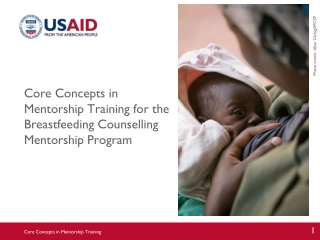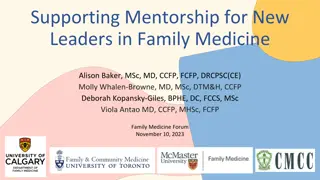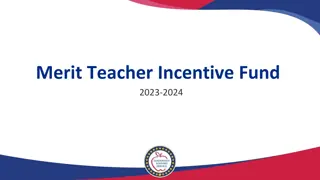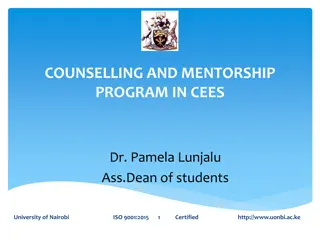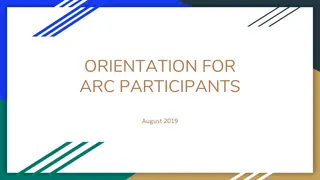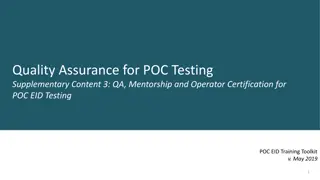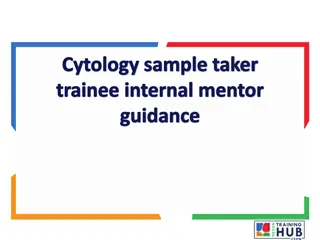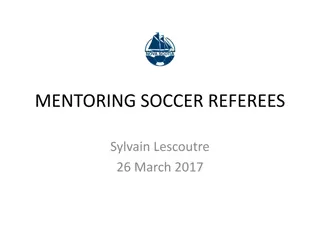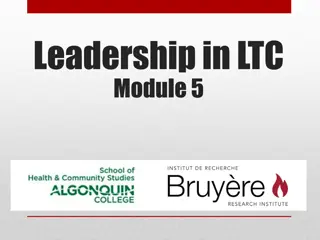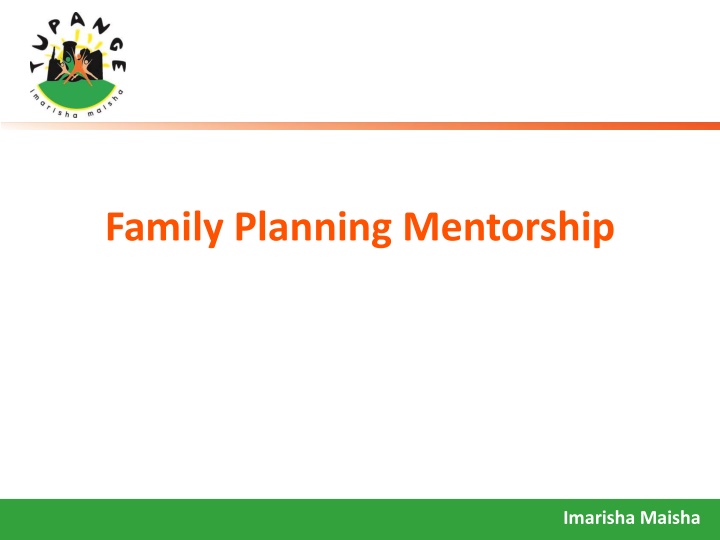
Clinical Mentoring and Effective Mentorship Relationships
Learn about the differences between mentorship and supervision, the key roles of a mentor, characteristics of a good mentor, and effective mentorship relationships in the context of family planning mentorship. Clinical mentoring involves a sustained, collaborative relationship where experienced healthcare providers guide others to improve care quality, while effective mentorship relationships are warm, safe, respectful, and trusting.
Download Presentation

Please find below an Image/Link to download the presentation.
The content on the website is provided AS IS for your information and personal use only. It may not be sold, licensed, or shared on other websites without obtaining consent from the author. If you encounter any issues during the download, it is possible that the publisher has removed the file from their server.
You are allowed to download the files provided on this website for personal or commercial use, subject to the condition that they are used lawfully. All files are the property of their respective owners.
The content on the website is provided AS IS for your information and personal use only. It may not be sold, licensed, or shared on other websites without obtaining consent from the author.
E N D
Presentation Transcript
Family Planning Mentorship Imarisha Maisha
What Is Clinical Mentoring? A sustained, collaborative relationship in which a highly experienced health care provider guides improvement in the quality of care delivered by other providers and the health care systems in which they work. 2
Difference between Mentorship and Supervision Overlap Mentorship Supportive Supervision Practical case management and skills improvement Management & administrative support: space, equipment and forms Patient flow and triage Clinic organization Updates on current developments and guideline changes Resources for organizational policies and procedures Patient monitoring and record-keeping Case reviews Career development opportunities for service providers (Training, staffing and other human resource issues) Team meetings Mentor acts as knowledge and skills resource Review of referral decisions More oriented to support health worker skills development Supply chain management, including provision of commodities for health worker protection Ensuring compliance with national protocols and guidelines Assists in actual service delivery and referral of complicated issues Patient satisfaction, linkages with facility and community On site availability complemented with distance communication 3
Roles of a Mentor Teacher/Educator Change agent/ Catalyst Coach Problem solver Advocate Process helper Friendly Resource person Colleague
Characteristics of a Good Mentor Adept at clinical knowledge and skills Has working knowledge and familiar with issues that may need addressing Enthusiastic and comfortable incorporating diverse situations/experiences into teaching Takes a back-seat approach to teaching, avoiding extensive lectures Allows mentee to explore and learn on his/her own Good understanding of clinical systems helps to address systemic issues 5
Characteristics of Effective Mentorship Relationships Both mentor and mentee want to be involved in mentoring relationship. Relationship is warm, safe, respectful, trustful. Mentor/mentee are able to process misunderstandings. Continuity of the relationship over time. Power is shared. Learning is two-way; mentor is interested in learner s ideas. Mentor listens to learner and the learner knows it. 6
Models of Clinical Mentoring Internal mentor External mentor Field-based mentoring teams 7
Internal Mentor Mentor is identified from among existing staff at a health care facility; already has clinical expertise, and receives training on how to mentor others Benefits: Sustainable model, mentor already knows system and its issues and challenges, so little time needed for preparation Challenges: Lack of appropriate human resources; perception of clinician as colleague, not mentor 8
External Mentor Placement of an expert clinician identified from within or outside the facility for a designated period of time at a specific facility Benefits: Draws from a larger pool of expert clinicians Challenges: Significant resources may be required to recruit, relocate, and orient the mentor to their site 9
Field-Based Mentoring Teams Multidisciplinary field-based teams provide ongoing clinical and systems mentoring to health facilities Benefits: Allow for key groups of expert staff to regularly visit a select number of clinical sites and provide intensive site support and clinical mentoring 10
Objectives of Tupange Mentorship Program Improve knowledge and skills of service providers on Family planning especially LAPMs Build capacity of local trainers and mentors to effectively conduct FP mentorship Assist to improve uptake of Family Planning , especially LAPMs
Mentorship Process 1. Introduction Informing sites/service delivery areas of intended visit Obtaining necessary permission and courtesy calls as appropriate 2. Site/individual assessment The mentorship team together with site staff (potential mentees) perform the initial assessment to identify service provider/facility gaps in FP service provision
Mentorship Process 3. Root Cause Analysis It is important to differentiate between the cause of a problem and the symptoms of a problem Treating the symptoms only leads to short term solutions Asking the question, Why? several times helps to identify the real reason or cause of a problem A single problem can have more than one root cause
Root Cause Analysis (Example 1 ) Why? Problem: No IUCD provision in facility Why? Why? Why? 14
Mentorship Process 4. Problem Prioritization Priority A - Those problems which, if not corrected, would cause FP program to collapse/stall. (Immediate action required), e.g lack of provider skills FP commodities, equipment, Priority B - Those problems which, if corrected, would improve FP service delivery. (Action required in the short term)
Mentorship Process 5. Planning: Setting target for improvement Collaboratively set a target for improvement (facility, individual targets) Decide on measures to achieve the target. Decide on time schedule to conduct mentorship/clinical teaching activities 6. Clinical Mentorship/Teaching Mentoring/teaching can take place over a number of sessions until clinical staff are competent in FP skills
Mentorship Process 7. Follow-up and evaluation: Periodically meet with mentee(s) to review action plans Reassessment can be done to identify persistent gaps that need to be addressed Set the date for the next mentorship visit
Facility/Individual Assessment AREAS THAT MENTEE IS DEFICIENT IN: Short-term methods POPs Condoms ECPs Specific details: _____________________________________________ __________________________________________________________ COCs SDM LAM Long term methods IUCD Specific details_________________________________________ ______________________________________________ Implants Cont d
Work plan template for mentoring Site / SERVICE DELIVERY AREA Mentor Mentee(s) Skills being mentored When: (Mentorship dates) Resources needed 19
Mentorship Log Book Name of Mentor: Date Skill Being Mentored Mentor Comments Next Skill to be mentored Date of next mentorship Mentee signature Mentor Signature
People Learn Differently I hear and I forget, I see and I remember, I do and I understand See one, do one, teach one
Summary Mentoring: Provides increased access to onsite training for health care workers in resource-limited settings. Aims to increase the skills of clinic staff and the efficiency of the clinic for the well-being of the patients.
Reference Materials National Guidelines on Mentorship for HIV Services in Kenya National Mentorship Training Orientation package for Service Providers

